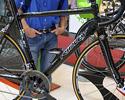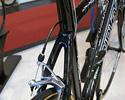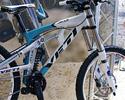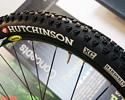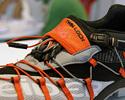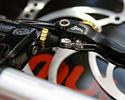
Recently on Cyclingnews.com |
Eurobike show
Germany, August 30-September 2, 2007
Main Page Previous Part Next Part
Part 3 - Things that go, things that roll, and things that stop
By James Huang in Friedrichshafen , Germany
Ridley revises top-end frames
|
|
|
The new Ridley Helium buys the Belgian company entry into the increasingly crowded 900g frame club. Ridley retained key features such as the integrated seat mast and oversized-and-tapered front end, but jettisoned just about everything else in the redesign. A new hollow-molding technique reportedly removes a bunch of excess material from inside the bottom bracket shell, while the relatively beefy wishbone-style seat stays are replaced by a pair of substantially slimmer ones. The new Helium is also now fitted with carbon fiber dropouts.
In spite of its more ethereal mass, though, Ridley says the new Helium is still plenty stiff. The top tube/head tube junction has been revised for better handling and the chain stays are more reinforced for improved drivetrain response.
The flagship Noah receives a moderate refresh, including an elongated head tube/top tube joint for more rigidity, and a revised chain stay profile that yields even more drivetrain stiffness than before (it was already frightening stiff in that area, so we can only wonder how fast it will go now). The Noah continues to use CNC-machined replaceable dropouts and weight has reportedly dropped to approximately 1100g.
Just in time for cyclocross season, Ridley also adds a second full carbon model to accompany its highly successful X-Night. The new X-Fire is more reasonably priced but shares the X-Night's championship-winning geometry. A box-section down tube improves front-end torsional rigidity, and the top tube flows gracefully into wishbone-style seat stays. Claimed frame weight is 1200g.
Yeti spotted in Friedrichshafen!
|
|
|
|
|
Yeti's planned release of a full carbon version of its pervasive AS-R SL frame wasn't exactly a secret, but the look of the final product was still a very pleasant surprise. The new AS-R C strikes a similar profile to the current model, yet the hugely oversized proportions scream of dramatic improvements in frame rigidity (sorely needed, we might add).
The super wide bottom bracket shell now houses Shimano's press-fit composite bottom bracket bearing cups instead of threads. This also allows the hexagonal down tube to take on equally wide proportions as it approaches the bottom end. The top tube is similarly shaped up front, then switches to a ‘T' shape at the forward shock mount before turning back up towards the… what the? Is that an integrated seat post on a mountain bike? Yup.
Scott was the first to bring the concept to the MTB mass market, but Yeti's system is still rather unique. Users can chop off the top of the frame to fit as intended (the seat post head allows for 25mm of height adjustment), or can saw it off at the base and attach a special clamp that allows for use of a standard 27.2mm post. Last year's 98mm-travel carbon rear end is mostly carried over from last year with the exception of a new random fiber finish, but the old aluminum link is now molded in carbon.
Claimed frame weight is 1.8kg (3.97lb) including a Fox RP23 shock, and suggested retail is US$2499 (frame only, of course). Yeti projects delivery dates beginning in January 2008.
The popular Yeti 575 gets reworked as well and even more thoroughly than the AS-R with an all-new aluminum front end and all-new carbon rear as well. As with the new AS-R C, Yeti ditches its once-trademark top tube knuckle in favor of a kinked hydroformed tube that is lighter and stiffer than previous iterations. The oversized hexagonal top tube flares at the head tube to reinforce the front end (which also includes a newly externally machined head tube), and Yeti's aging plate-style upper shock linkage mount is replaced by a more sophisticated tubular aluminum structure.
The 575 also gets a new rear end with carbon fiber chain stays as well as carbon seat stays that include a unique bridge to keep things tied together. Rear travel remains at 150mm using Yeti's tried-and-true variable leverage ratio linkage design, but weight has dropped to just 2.7kg (5.95lb) including the now-standard titanium hardware kit. Less expensive aluminum rear ends will also be offered which add 200g. Delivery is scheduled to begin in late October.
But wait, there's more! Yeti's innovative 303 DH race bike gets a wholly revamped aluminum front end that lops a whopping 225g (0.5lb) from last year's version, largely due to the new butted and tapered hydroformed top tube. A new lighter and stiffer tubular aluminum strut bridges the top tube and down tube while also providing the forward mount for the upper rail. Last year's suspension design remains unchanged for 2008.
Tubeless cyclo-cross tires, just in time for the season
|
|
|
Hutchinson has adapted its outstanding Road Tubeless design for use on cyclo-cross tires. The new Tubeless Ready tires shared similar bead geometry as the high pressure Road Tubeless Fusion 2 clinchers but skip the carbon beads for more conventional aramid fibers (there's no need for carbon here since the pressures are substantially lower).
The new Tubeless Ready Piranha and Bulldog require the use of latex sealant to make them airtight, but the 405g claimed weights (both models, 700x34c) should make them awfully appealing to the racing crowd, if only for their ability to run at lower pressures without fear of pinch flats.
Unfortunately, the system still requires the use of Shimano's Road Tubeless Dura-Ace rim for proper function, but Hutchinson still insists that other wheel manufacturers have compatible models in development.
For the MTB set, Hutchinson continues to revise its tread designs and develop new ones as it sees fit. The new Toro is somewhat similar to the existing Bulldog but with more aggressive knobs that reach further down the side of the casing for better cornering performance, especially in softer and looser conditions. A new Hardskin technology adds a puncture resistant layer from bead-to-bead, supposedly without adding significant weight or detracting from ride quality. Sizes ranging from 26x1.85-2.35” will be offered.
The new Rhino also features Hardskin technology but its tall spiky knobs are specifically designed for use in extremely soft conditions such as mud. The reinforced 66tpi dual-ply casing is also designed to resist pinch flatting during DH use.
Formula pitches to the DH masses
|
|
|
Formula improves on its already-powerful Oro line of brakes to yield two new models specifically aimed at the downhill crowd. The new ‘The One' brake supposedly delivers a 20% increase in stopping power via larger 24mm-diameter pistons housed in a one-piece forged aluminum caliper body.
The matching master cylinder boasts a new pushrod actuation linkage that provides a more linear piston action, and external adjustments include pad contact point and lever reach. A built-in mechanism allows the lever to safely hyperextend in the event of a crash. For really bad wrecks, though, a pair of intentional notches in each lever creates a predictable cleavage point that still leaves a usable stub behind for safe operation. In spite of the added power, though, Formula claims the ‘The One' brake weighs the same as the current Oro K24.
A lower-priced Mega brakeset offers the same piston dimensions and stopping power of ‘The One' but makes do with a two-piece caliper body. That body does, however, boast an offset split line that allows the use of shorter bolts for better caliper rigidity. The master cylinder retains the aluminum pad contact point adjuster, but reach adjustments must be accomplished with a 3mm hex wrench.
Photography
For a thumbnail gallery of these images, click here
Images by James Huang/Cyclingnews.com
- The new Ridley Helium now tips the scales at just 900g (claimed) and also is supposedly stiffer than last year's model.
- New hollow-molding technology reportedly removes 'significant excess material' from the interior of the bottom bracket shell.
- Slender seat stays drop weight and will probably also add some vertical compliance.
- The Noah is revised for next year with updated tube shapes that make it even more rigid than before.
- An elongated head tube/top tube junction improves front-end stiffness.
- New chain stay profiles are more rounded on top than before.
- The Ridley X-Fire hits just in time for cyclocross season.
- Wishbone-style seat stays and chain stays define the rear end of the X-Fire.
- Plenty of carbon here, as usual.
- Ridley makes mountain bikes? Perhaps not very many, but its collection does include this carbon fiber hardtail.
- The Yeti AS-R line now adds a carbon fiber family member with a full carbon front end matched to the existing carbon rear triangle.
- An integrated seatpost on a mountain bike?! Yes, but Yeti says there is 25mm of adjustment once the mast has been cut, and it can also be cut at the base and used with a standard 27.2mm when matched with a special clamp.
- The substantially beefier head tube area bodes well for torsional rigidity, which was somewhat lacking in the aluminum version.
- The AS-R rear suspension system remains mostly intact, but it now has a more substantial anchor to pivot about.
- The aluminum shock linkage is upgraded to carbon fiber on the new model.
- Nope, no threads to be found here.
- The composite press-fit bottom bracket bearing cups that Shimano originally developed for Scott find their way into the new Yeti to drop weight.
- The new threadless bottom bracket shell is also wider, enabling Yeti to use a much broader down tube for increased frame stiffness.
- Yeti's versatile 575 is totally revamped for 2008 , with an all-new aluminum front end and carbon rear triangle.
- The new carbon rear end also includes an integrated bridge that ties the front ends of the seat stays together.
- Yeti has finally moved away from the rather simplistic plates forming the upper shock linkage pivot, opting now for a stiffer tube-type construction.
- The shock linkage itself is still machined from aluminum , although it now wears a more elegant shape.
- The hydroformed top tube is particularly beefy up at the head tube, and Yeti has done away with its trademark machined top tube knuckle in favor of the lighter (and probably more rigid) kinked design.
- The 303 receives attention as well , in the form of an all-new front triangle that helps shave over 200g from last year's model.
- The Yeti 303 still uses the unique railed rear suspension design.
- Rail 'cars' incorporate a small grease fitting to help maintain smooth operation.
- Zero Loss Technology': Hmm… we wonder if SRAM has a problem with this naming!
- Urban legend says something about a Yeti being spotted within the halls of Eurobike…
- Woo-hoo! Finally, Hutchinson launches its much-anticipated line of Tubeless Ready cyclocross tires.
- The new Tubeless Ready 'cross treads are still only officially compatible with Shimano's Road Tubeless Dura-Ace wheelset, but two different tread types are offered.
- The new Toro is somewhat similar in appearance to the existing Bulldog , but the side knobs reach further out for more predictable cornering and the Hardskin-reinforced casing should be more resistant to punctures.
- The Rhino is specially designed for use in soft and muddy conditions.
- The Iguana is a new price-point tire for Hutchinson and will eventually replace the Spider.
- Hutchinson launces a new training tire called Nitro.
- Hutchinson worked with popular European shoemaker Eider to produce the tread pattern on the bottom of this shoe.
- Does any part of this look familiar?
- Formula's excellent Oro Puro brake stays mostly unchanged for 2008.
- The new Formula DH-specific 'The One' brake reportedly generates 20% more stopping power than the Oro.
- A rotatable banjo makes for cleaner hose routing.
- The master cylinder includes external adjustments for both reach and pad contact point.
- A unique hyperextendable lever fends off damage to the internals, but intentional notches in the lever provide a built-in failure point in the event of a crash that still leaves enough lever blade to function.
- The new Formula Mega uses the same piston size as The One but a two-piece caliper.
- The offset split plane in the caliper allows for a shorter bolt to improve caliper rigidity.
- The Formula Mega master cylinder offers the same hyperextendable lever and FCS functionality, but requires a 3mm wrench to adjust the reach.
- New lower profile clamps provide better compatibility with some shifters.

